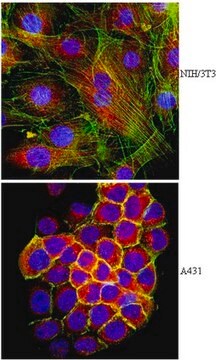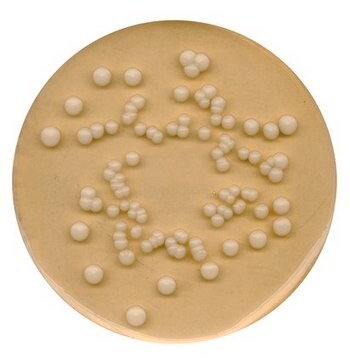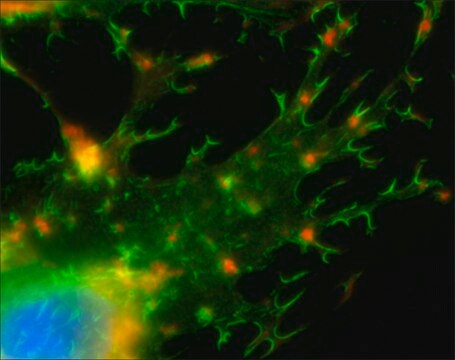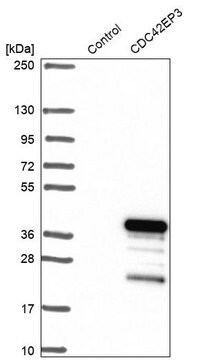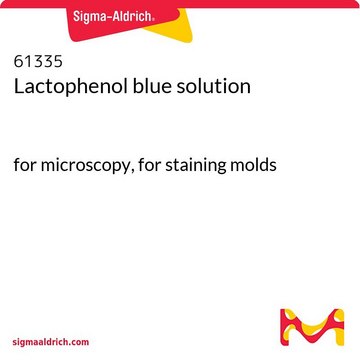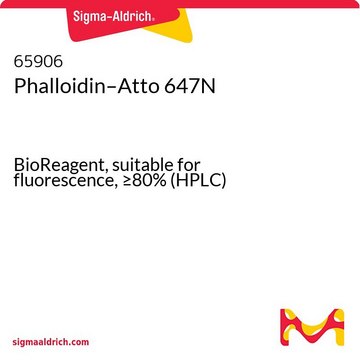93042
Phalloidin–Atto 590
suitable for fluorescence, ≥90%
Faça loginpara ver os preços organizacionais e de contrato
About This Item
Código UNSPSC:
12352108
NACRES:
NA.32
Produtos recomendados
Ensaio
≥90%
Formulário
solid
peso molecular
Mw 1473 g/mol
fabricante/nome comercial
ATTO-TEC GmbH
fluorescência
λex 594 nm; λem 624 nm in 0.1 M phosphate pH 7.0
adequação
suitable for fluorescence
temperatura de armazenamento
−20°C
Descrição geral
Atto 590 is a novel fluorescent label that belongs to the class of Rhodamine dyes. It shows a strong absorption, high fluorescence quantum yield, high thermal and photostability, and a very little triplet formation. Atto 590 consists of a mixture of two isomers with practically identical optical absorption and emission Phalloidin is a fungal toxin isolated from the poisonous mushroom Amanita phalloides. Its toxicity is attributed to the ability to bind F actin in liver and muscle cells. As a result of binding phalloidin, actin filaments become strongly stabilized. Phalloidin has been found to bind only to polymeric and oligomeric forms of actin, and not to monomeric actin. The dissociation constant of the actin-phalloidin complex has been determined to be on the order of 3 x 10-8. Phalloidin differs from amanitin in rapidity of action; at high dose levels, death of mice or rats occurs within 1 or 2 hours. Fluorescent conjugates of phalloidin are used to label actin filaments for histological applications. Some structural features of phalloidin are required for the binding to actin. However, the side chain of amino acid 7 (g-d-dihydroxyleucine) is accessible for chemical modifications without appreciable loss of affinity for actin.
find more information here
find more information here
Código de classe de armazenamento
11 - Combustible Solids
Classe de risco de água (WGK)
WGK 3
Ponto de fulgor (°F)
Not applicable
Ponto de fulgor (°C)
Not applicable
Escolha uma das versões mais recentes:
Já possui este produto?
Encontre a documentação dos produtos que você adquiriu recentemente na biblioteca de documentos.
Os clientes também visualizaram
Yu Zhang et al.
Aging, 10(12), 3736-3744 (2018-12-18)
Protein kinase D (PKD) subfamily which includes PKD1, PKD2 and PKD3 is a novel family of serine/threonine kinases. PKD has been widely implicated in the regulation of multiple physiological effects including immune responses, apoptosis and cell proliferation. However, the roles
Yu Zhang et al.
Journal of cellular physiology, 234(10), 18513-18523 (2019-03-27)
Cytoskeleton which includes microtubule and actin filaments plays important roles during mammalian oocyte maturation. In the present study, we showed that protein kinase C mu (PKC mu) was one potential key molecule which affected cytoskeleton dynamics in mouse oocytes. Our
Stimulated emission depletion-based raster image correlation spectroscopy reveals biomolecular dynamics in live cells.
Hedde P.N.; et al.
Nature Communications, 4, 2093-2093 (2013)
Munc18-1 Tuning of Vesicle Merger and Fusion Pore Properties.
Jorgacevski, J.; et al.
The Journal of Neuroscience, 31(24), 9055-9066 (2011)
SNARE Function Is Not Involved in Early Endosome Docking.
Geumann, U.; et al.
Molecular Biology of the Cell, 19(12), 5327-5337 (2008)
Nossa equipe de cientistas tem experiência em todas as áreas de pesquisa, incluindo Life Sciences, ciência de materiais, síntese química, cromatografia, química analítica e muitas outras.
Entre em contato com a assistência técnica

